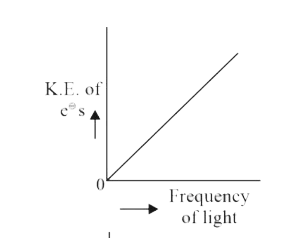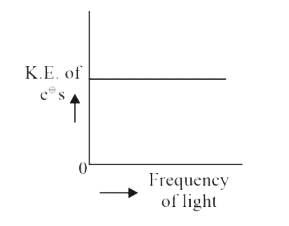Which of the graphs shown below does not represent the relationship between incident light and the electron ejected from metal surface?




The correct Answer is:A
To solve the question regarding which graph does not represent the relationship between incident light and the electrons ejected from a metal surface, we can follow these steps:
1. Understanding the Photoelectric Effect:
- The photoelectric effect describes the phenomenon where electrons are ejected from a metal surface when it is exposed to light of sufficient frequency. The energy of the incident light must exceed a certain threshold energy (E₀) for electrons to be emitted.
2. Kinetic Energy of Ejected Electrons:
- The kinetic energy (K.E.) of the ejected electrons can be expressed by the equation:
K.E.=E−E0
where E is the energy of the incident light and E0 is the threshold energy.
3. Graphical Representation:
- The relationship between the frequency of incident light (ν) and the kinetic energy of the ejected electrons can be represented by the equation:
K.E.=hν−hν0
where h is Planck's constant and ν0 is the threshold frequency. This implies that:
- The slope of the graph of kinetic energy (K.E.) vs. frequency (ν) is h.
- The intercept on the K.E. axis is −hν0.
4. Analyzing the Given Graphs:
- Graph 1: If this graph starts from the origin (0,0) and has an intercept, it does not correctly represent the relationship because the K.E. should not be zero when the frequency is below the threshold frequency.
- Graph 2: If this graph has a positive slope and a non-zero intercept, it could represent a valid relationship.
- Graph 3: If this graph plots the number of ejected electrons against frequency, it is also valid.
- Graph 4: If this graph shows K.E. against intensity, it is incorrect since K.E. does not depend on intensity.
5. Conclusion:
- Based on the analysis, Graph 1 does not represent the correct relationship between incident light and the ejected electrons from the metal surface.
Final Answer:
Graph 1 is the correct answer as it does not represent the relationship between incident light and the electron ejected from the metal surface.
- The photoelectric effect describes the phenomenon where electrons are ejected from a metal surface when it is exposed to light of sufficient frequency. The energy of the incident light must exceed a certain threshold energy (E₀) for electrons to be emitted.
- The kinetic energy (K.E.) of the ejected electrons can be expressed by the equation:
K.E.=E−E0
where E is the energy of the incident light and E0 is the threshold energy.
- The relationship between the frequency of incident light (ν) and the kinetic energy of the ejected electrons can be represented by the equation:
K.E.=hν−hν0
where h is Planck's constant and ν0 is the threshold frequency. This implies that:
- The slope of the graph of kinetic energy (K.E.) vs. frequency (ν) is h.
- The intercept on the K.E. axis is −hν0.
- Graph 1: If this graph starts from the origin (0,0) and has an intercept, it does not correctly represent the relationship because the K.E. should not be zero when the frequency is below the threshold frequency.
- Graph 2: If this graph has a positive slope and a non-zero intercept, it could represent a valid relationship.
- Graph 3: If this graph plots the number of ejected electrons against frequency, it is also valid.
- Graph 4: If this graph shows K.E. against intensity, it is incorrect since K.E. does not depend on intensity.
- Based on the analysis, Graph 1 does not represent the correct relationship between incident light and the ejected electrons from the metal surface.
Graph 1 is the correct answer as it does not represent the relationship between incident light and the electron ejected from the metal surface.
Topper's Solved these Questions
- BOOK - VMC MODULES ENGLISHCHAPTER - ATOMIC STRUCTUREEXERCISE - JEE Advanced (Archive )67videos
ATOMIC STRUCTURE
- BOOK - VMC MODULES ENGLISHCHAPTER - ATOMIC STRUCTUREEXERCISE - LEVEL - 2 ( Numerical value type for JEE Main )16videos
ATOMIC STRUCTURE
- BOOK - VMC MODULES ENGLISHCHAPTER - AMINESEXERCISE - IN CHAPTER EXERCISE H10videos
AMINES
- BOOK - VMC MODULES ENGLISHCHAPTER - CHEMICAL BONDING & CHEMICAL STRUCTURE EXERCISE - IMPECCABLE50videos
CHEMICAL BONDING & CHEMICAL STRUCTURE
Similar Questions
Knowledge Check
- Question 1 - Select One
Assertion : The number of electrons ejected from a metal surface depend upon the frequency of light.
Reason : There is a time lag between the striking of light beam and the ejection of electrons from the metal surface.AIf both assertion and reason are true and reason is the correct explanation of assertion.BIf both assertion and reason are true but reason is not the correct explanation of assertion.CIf assertion is true but reason is false.DIf both assertion and reason are false. - Question 2 - Select One
Which of the following inequalities represents the graph shown below on the real number line ?
 A0<x<5B0<x≤4C−2<x≤4D1≤x≤4
A0<x<5B0<x≤4C−2<x≤4D1≤x≤4 - Question 3 - Select One
Assertion : The threshold frequency of photoelectric effect supports the particle nature of light.
Reason : If frequency of incident light is less than the threshold frequency, electrons are not emitted from metal surface.AIf both assertion and reason are true and reason is the correct explanation of assertion.BIf both assertion and reason are true but reason is not the correct explanation of assertion.CIf assertion is true but reason is false.DIf both assertion and reason are false.
Linear relationship exists between incident light and rate of CO2 fixation at/in.
View SolutionIf λoandλ be the threshold wavelength and wavelength of incident light , the velocity of photoelectron ejected from the metal surface is :
View SolutionWhich of the following graphs represents the relationship between the force F between two point charges and the distance r between them :
View Solution
A metal surface in an evacuated tube is illuminated with monochromatic light causing the emission of photoelectrons. For a given intensity of light, a graph between saturation current and potential of the electrode is given in Fig. If the experiment were repeated with light of twice the intensity but the same wavelength, which of the graphs below would best represent the new relation between I and V?(Dotted represents initial condition)View SolutionWhich one of the following function best represents the graphs as shown below?
 View Solution
View Solution
